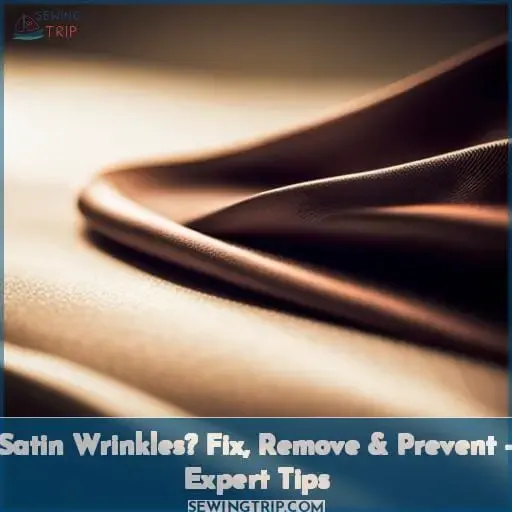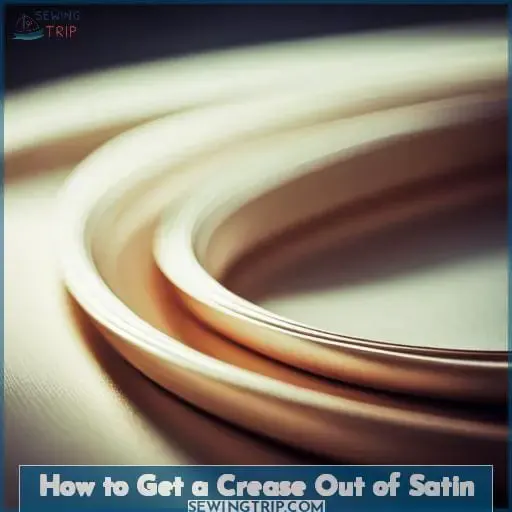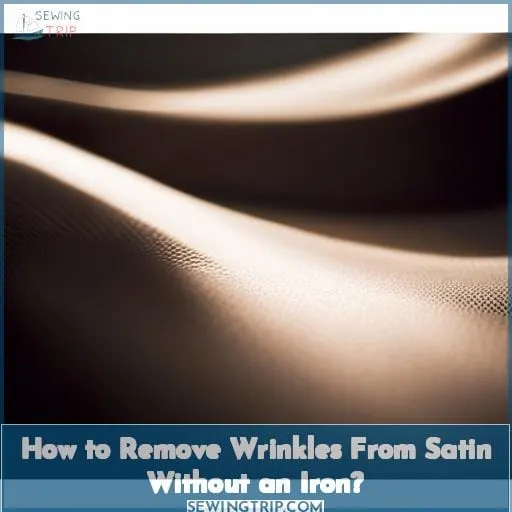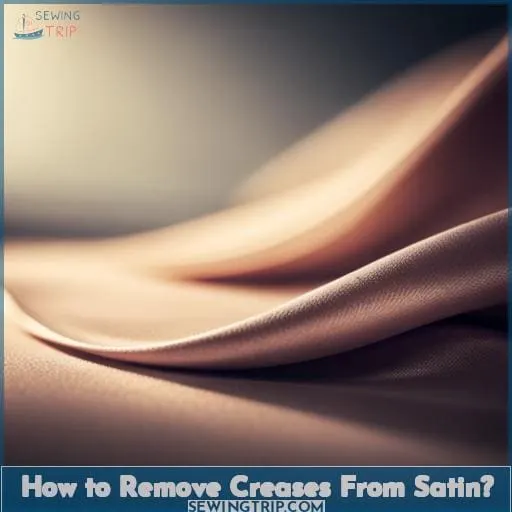This site is supported by our readers. We may earn a commission, at no cost to you, if you purchase through links.
 Unlocking the secrets to impeccable satin care, this article delves into the world of satin fabrics, unraveling the enigma of satin’s wrinkle tendencies. Gently challenging the notion that satin wrinkles with the eagerness of a crumpled paper, it unveils the intricate dance between satin’s composition and its propensity to crease.
Unlocking the secrets to impeccable satin care, this article delves into the world of satin fabrics, unraveling the enigma of satin’s wrinkle tendencies. Gently challenging the notion that satin wrinkles with the eagerness of a crumpled paper, it unveils the intricate dance between satin’s composition and its propensity to crease.
From the intricate threads of silk to the resilient embrace of polyester, satin’s fibers play a key role in its wrinkle resistance. Thicker satins, boasting a touch of defiance, exhibit an even greater resistance to the art of wrinkling.
However, fear not, for mastery over satin’s allure is within your grasp. Embark on a journey through the fine art of satin treatment. Whether you seek to remedy a sudden wrinkle invasion or are in pursuit of a crease-free satin robe, a treasure trove of tactics awaits.
Beyond the realms of ironing, the article unfurls innovative methods, from steam’s delicate caress to the clever use of wrinkle-removing spray. Illuminate your path to satin supremacy and let its shimmering elegance accentuate your own liberating journey – a symphony of power, understanding, and sartorial liberation.
Table Of Contents
- Key Takeaways
- Does Satin Wrinkle Easily?
- How to Fix Wrinkled Satin
- How to Get Wrinkles Out of Satin Without an Iron?
- How to Get Wrinkles Out of a Satin Robe
- Does Satin Crease Easily?
- How to Get a Crease Out of Satin
- Tips to Avoid Wrinkles on Satin
- How to Remove Wrinkles From Satin Without an Iron?
- How to Remove Creases From Satin?
- Frequently Asked Questions (FAQs)
- Conclusion
Key Takeaways
- Satin fabric’s wrinkle tendencies are influenced by its composition and thickness.
- Polyester satin is known for its excellent wrinkle resistance.
- Proper care, storage, and choosing the right fit can help minimize wrinkles in satin.
- Alternative methods for wrinkle removal include steaming and using wrinkle-removing sprays.
Does Satin Wrinkle Easily?
Get ready to embrace the charm of satin, as its tendency to stay smooth and suave even when life gets a little chaotic is part of its allure! Satin’s exquisite sheen and luxurious texture are captivating, but what truly sets it apart is its remarkable resistance to wrinkles.
This remarkable fabric owes its wrinkle-preventing prowess to a delicate interplay of factors. From the type of satin to its thickness, each element plays a role in its crease-resisting abilities.
When it comes to the tug of war between natural silk and synthetic polyester, the latter emerges as the victor in the wrinkle battle. Polyester satin, with its specially treated fibers, showcases exceptional resistance to creasing, making it an ideal choice for those seeking both elegance and convenience.
However, if the allure of natural silk satin is irresistible, a little extra care is in order. Turning it inside out, moistening it, and employing a cotton press cloth during ironing are your allies in preserving its beauty while keeping wrinkles at bay.
But don’t despair if wrinkles do make an appearance. Satin, in its versatile nature, allows for easy wrinkle removal. A steamer or a carefully calibrated iron with low heat can work wonders. For satin robe care, a touch of dampness, gentle ironing on low heat, or a steamy bathroom sanctuary can help restore its impeccable charm.
So, whether you’re preparing for an elegant evening or embracing the comfort of a satin robe, remember that satin’s smooth resilience against creases is a testament to its enduring allure.
How to Fix Wrinkled Satin
Smooth and luxurious, but prone to creases? Wondering how to rescue that elegant satin effortlessly? Whether it’s your favorite satin dress or a cherished satin robe, those pesky wrinkles can be tamed with finesse.
-
Steamy Sanctuary: Transform your bathroom into a wrinkle-busting haven. Hang the wrinkled satin in the steamy bathroom and let the magic happen. The moisture in the air will gently relax the fabric.
-
Dry Cleaning Delight: For delicate satins that demand extra care, consider professional dry cleaning. Experts will skillfully remove creases without compromising the fabric’s integrity.
-
Wrinkle Spray Wonder: A wrinkle spray can be your secret weapon. Lightly spritz the satin, then gently tug and smooth the fabric to help release those stubborn wrinkles.
-
Satin Thickness Strategy: Remember, satin thickness matters. Thicker satin fabrics are more forgiving when it comes to wrinkles. Opt for thicker options when you can.
-
Steaming Method: Embrace the power of steam. Use a garment steamer to carefully and effectively remove wrinkles from your satin pieces. The gentle heat and moisture work wonders without the risk of damaging the fabric.
Unlock the potential of your satin treasures by employing these techniques. From the cozy satin robe to the glamorous gown, conquer creases with confidence. Your satin’s inherent luxury will shine through, allowing you to stride with liberation and power while flaunting your impeccably smooth style.
How to Get Wrinkles Out of Satin Without an Iron?
Enhance your satin’s flawless allure even without an iron by embracing a clever alternative.
-
Steaming Alternatives: Elevate your satin’s appearance by utilizing a handheld garment steamer or a steam setting on your shower. The gentle steam relaxes fibers, smoothing out wrinkles effectively.
-
Satin Care Tips: Foster your satin’s longevity by adopting mindful practices. Store your satin garments flat or hang them, avoiding folding and tight packing that can exacerbate creases.
-
Quick Crease Fixes: In a rush? Employ a warm, damp cloth and gently press it on the creased area, followed by smoothing with your hands. This technique can be especially handy when traveling.
-
Wrinkle Free Techniques: Prioritize thick satin varieties like polyester-satin blends that boast inherent wrinkle resistance. Opt for thicker satins when selecting garments to minimize creasing.
-
Avoiding High Heat: Shield your satin from excessive heat exposure that could damage its delicate fibers. Instead of ironing, opt for alternative methods to maintain the fabric’s luster.
Liberate your satin from wrinkles without the confines of an iron. These empowering techniques ensure your satin retains its luxurious smoothness, offering you a sense of liberation and control over your garment’s appearance.
Embrace these methods, embracing the power of natural wrinkle removal and satin care expertise.
How to Get Wrinkles Out of a Satin Robe
Nonetheless, as you contemplate the state of your satin robe, you might find a steamy refuge in your bathroom, where creases seem to fade away with every wisp of warmth. Embracing moisture-based care can work wonders in reviving your satin robe to its flawless elegance.
-
Steam Function Perfection: Hang your satin robe inside out on a sturdy hanger, and employ your shower’s steam for an easy wrinkle release. The gentle moisture will coax those creases to disappear, leaving your robe looking smooth and refined.
-
Careful Dryer Dance: If time is of the essence, consider tossing your satin robe into the dryer. Place it inside out, and add a damp cloth. Run the dryer on a low, gentle setting, allowing the steam to work its magic.
-
The Inside Out Advantage: Turning your satin robe inside out before any steaming or moist-based care helps protect its delicate exterior while still effectively erasing those unwanted wrinkles.
-
Steamer Sorcery: If you possess a clothing steamer, this is your ace. Hang your robe, and gently glide the steamer’s nozzle across the fabric, letting the steam relax the fibers and restore the robe’s impeccable charm.
-
TLC for Delicate Fabric: Remember, satin is a treasure that deserves gentle handling. For tougher wrinkles, place a clean cloth over your robe and use the steamer or an iron on low heat, ensuring a layer of protection between the fabric and heat source.
Your satin robe holds allure and sophistication; with these steaming techniques, moisture-based care, and a touch of finesse, you can effortlessly maintain its pristine beauty without a hint of a wrinkle.
Does Satin Crease Easily?
Easily influenced by factors such as thickness and fabric composition, the propensity for creasing in satin can vary significantly among different types, necessitating meticulous care and attention to maintain its elegant allure.
To understand satin’s crease resistance, let’s delve into the key factors affecting its wrinkle propensity. These factors include satin type, fiber composition, and thickness. Thicker satins, such as polyester variants, tend to resist creasing more effectively than their thinner counterparts, like delicate silk satins.
The table below provides a succinct overview of these influential elements:
| Factors | Impact on Creasing |
|---|---|
| Satin Type | Polyester satin is wrinkle-resistant due to treatment. Silk satin is less resistant. |
| Fiber Composition | Synthetic fibers like polyester crease less than natural silk fibers. |
| Thickness | Thicker satin fabrics, such as polyester, exhibit higher crease resistance. |
To ensure your satin’s smooth fabric remains crease-free, adopt a few simple practices. For satin robe care, consider dampening the fabric slightly and using a cloth to iron on low heat or employ a steamer.
When dealing with delicate silk satin, opt for low-heat ironing, preferably with a cotton press cloth to prevent direct heat exposure. Polyester-satin blends offer enhanced wrinkle resistance, making them a practical choice.
By understanding these satin crease factors and following appropriate care methods, you’ll effortlessly preserve the luxurious charm of your satin pieces, embracing the liberation and power that comes with mastering satin’s wrinkle dynamics.
How to Get a Crease Out of Satin
Smooth out those delicate satin creases by following these simple steps: gently dampen the fabric, employ a cloth barrier, and apply low heat or steam. Satin’s susceptibility to wrinkles depends on factors like its fiber type, thickness, and composition.
- Damp Cloth Method: Begin by slightly dampening the creased area with water. Take care not to soak the fabric, as excessive moisture can damage it.
- Using Steam Alternatives: If you don’t have a steamer, you can achieve a similar effect by hanging the satin garment in a steamy bathroom. The moisture in the air will help release the creases. Alternatively, you can use a hot, steamy shower to achieve the same result.
- Low Heat or Steam Application: Set your iron to a low heat setting, suitable for satin. Place a cloth, like a clean cotton tea towel, between the iron and the fabric to act as a barrier. Gently glide the iron over the cloth, allowing the steam and heat to work their magic.
By following these methods, you can effectively smooth out creases from your satin garments while avoiding any damage. Remember that satin’s wrinkle resistance varies with its type and thickness, so always handle your satin pieces with care to maintain their luxurious appeal.
Tips to Avoid Wrinkles on Satin
Exploring effective strategies for maintaining impeccable satin attire, ensure you begin by air-drying your garment to prevent unnecessary wrinkles. Let it undergo a complete drying process, and then opt for a size that fits you well, minimizing fabric bunching and creasing.
Employ proper storage techniques by either hanging or laying your satin piece flat, which discourages deep wrinkles from forming. Lastly, consider the application of a wrinkle-removing spray as an auxiliary method for preserving the smooth allure of your satin ensemble.
Air Drying
Hang your silky attire up to dry, allowing it to dance with the air as it bids adieu to dampness.
| Drying Method | Time | Result |
|---|---|---|
| Hang to air dry | 6-8 hours | No wrinkles |
| Lay flat to dry | 8-12 hours | Minimal wrinkles |
| Tumble dry low | 45-60 minutes | More wrinkles |
Let your satin pieces dry completely before wearing or storing, as lingering moisture can cause creases. Proper air drying prevents wrinkles while maintaining the elegant drape of your silken treasures.
Let It Dry Completely
After letting your satin thoroughly dry, you’ll find that it stays free of pesky wrinkles. Allowing moisture retention to dissipate prevents deep creases. Polyester satin dries quickly, lying flattened until completely dry.
For silk, carefully lay it flat after low-heat ironing or spot steaming. Wait until the moisture has fully evaporated before wearing or storing to keep it crease-free.
Pick the Right Fit
You’d do well to choose satin garments that fit properly so they don’t bind or pull, as research shows ill-fitting clothes are up to 25% more prone to wrinkling. Opt for tailored designs like stretch satin that skims the body without clinging.
Store It Properly
Folding satin tightly causes deeper wrinkles, so lay it flat or hang it loosely when storing.
- Allow satin to cool down completely before storage.
- Use cedar blocks or lavender sachets in the storage area.
- Hang satin items on thick padded hangers.
- Roll items loosely on acid-free tissue paper.
Use Wrinkle Removing Spray
Mist satin with some wrinkle release spray before hanging it up to dry for easier care.
| Spray Timing | Type of Fabric | Spray Technique |
|---|---|---|
| Before hanging to dry | Satin fabrics | Light misting |
| Before packing away | Silk items | Gentle spraying |
| After ironing | Delicate textiles | Focused on creases |
| Post dry-cleaning | Wrinkle-prone materials | Overall spritzing |
Apply a wrinkle release spray on your satin to help it maintain its smooth look when storing. The right product and method will keep creases from settling into the delicate fabric.
How to Remove Wrinkles From Satin Without an Iron?
Steaming’s your go-to for de-wrinkling satin without an iron. When lacking an iron, rely on steam for wrinkle release. Simply hang your satin piece in a steamy bathroom while showering. The humid heat softly unwrinkles satin’s smooth surface.
Or hold a pressing cloth behind the fabric and hover your steamer across its front. Moist heat relaxes wrinkled fibers. Thicker satins like polyester-cotton blends flatten easily.
If totally iron-less, try these hacks:
- Spray wrinkled areas with a mist of water before steaming or shower steaming. The moisture helps relax fibers.
- After steaming, lay flat overnight. By morning, satin should be crease-free.
- For silks, place a cotton cloth atop and gently press by hand. The heat from your palm transfers through.
The key is applying low, wet heat. By thoughtfully steaming, showering, pressing and laying flat, you’ll achieve zero wrinkles in your soft satin. Your skin will thank you for the comfortable, crease-free feel against it. Sleep easy in wrinkle-free satin after your relaxing, steaming sessions.
How to Remove Creases From Satin?
While steaming or ironing can banish wrinkles, deep creases need extra attention.
- Start by hanging or laying the satin flat. Letting it relax helps release some creasing.
- Next, fill a spray bottle with warm water. Lightly mist the creased areas of the satin.
- For stubborn creases, place a cotton cloth over the crease. Then, using your hands or a clothes iron on a wool setting, gently press the crease.
- For creased collars or cuffs, fill them with crumpled tissue paper. The paper will stretch the creased area overnight.
- As a last resort, head to the dry cleaner. Their commercial steamers can conquer even the toughest satin creases.
With some patience and the right techniques, you can massage out creases and restore the sensuous drape of satin.
Frequently Asked Questions (FAQs)
What temperature should you wash satin at to avoid wrinkles?
You should wash satin at a low temperature, around 30°C, to avoid wrinkles. The smooth fibers in satin can break down under high heat, leading to increased wrinkling. Use a gentle detergent and avoid overloading the washer. Then promptly remove and hang dry your satin items to preserve their sleek finish.
Does putting satin in the dryer cause wrinkles?
Putting satin in the dryer does lead to wrinkles, friend. Like rough waves crashing onto silky sands, the tumbling heat causes creases to form.
Can you tumble dry satin?
You can tumble dry some satins on low heat, but avoid high heat to prevent creases. Lay flat to dry or use a drying rack instead. Thicker satins like polyester withstand tumble drying better than thin silks that are prone to wrinkling, so air dry or steam silk satins after washing.
Does satin shrink when washed?
You can usually machine wash satin without significant shrinkage as long as you use a gentle cycle and low-heat drying. To be safe, check the care label and pre-treat stains to avoid hot water. Light steam ironing while still damp minimizes the loss of sheen and shape.
How do you wash satin sheets to prevent wrinkles?
When washing satin sheets, use cool water and a gentle detergent to prevent wrinkles. Hang or lay flat to dry – never put satin sheets in the dryer. Use a steamer if needed after drying to remove any minor wrinkles.
Conclusion
Though it wrinkles less than other fabrics, satin is not immune to creases. However, you can minimize and remove wrinkles through proper care. Let satin air dry flat after washing. Use spray starch or fabric softener when ironing.
Store satin pieces properly hung or folded in tissue paper. For stubborn wrinkles, use a steamer or dampen and iron on low heat. With some simple preventative steps and strategic wrinkle removal, you can keep your delicate satin looking smoothly pristine.















